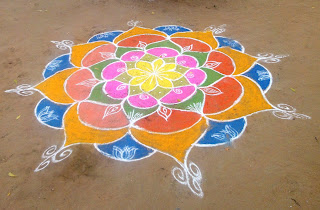 |
| Kolam for Pongal festival in Amoor cottages |
“Rangoli
is drawn in front of the house as a faith and tradition” said Devi a rural
woman in Sirugamani village. She also said, “Rangoli is known as Kolam. Rangoli designs can be simple geometric
shapes, deity impressions, or flower and petal shapes appropriate for the given
celebrations. Kolams are decorative designs made on the floors of living rooms
and courtyards in Tamilnadu. Kolam represents a philosophy of life that
enthusiastically celebrates the impermanence of knowing and devotes itself to a
constant wish to live in the present. The idea that tomorrow will be renewed,
which is the purpose of the rangoli, is one of the greatest concerning this
symbol. Women may make rangoli at the entrance to every room of the house.
Rangoli created with icons, such as the swastika, lotus flower, etc., are
considered indicators of prosperity. The art has become a part of the family.
It is a symbol of human spirit and an important means to realize cultural
feelings. Rangoli symbolizes joy and happiness. Rangoli drawn by chalk or stone
powder using interconnecting dots or flowery designs are most often. They are
meant to be sacred welcoming areas. The ancient symbols have been passed down
through the ages, from each generation to the next, keeping both the art form
and the tradition alive. The patterns are typically created with materials
including colored rice, dry flour, and colored sand. The purpose of Rangoli is
decoration, and it is thought to bring good luck. Design-depictions may also
vary as they reflect traditions, folklore and practices that are unique to each
area. It is traditionally done by women. Generally, this practice is showcased
during occasions such as festivals, auspicious observances, celebrations of
marriages and other similar milestones and gatherings. Therefore this art rich
- poor is prevalent in all homes. Hospitality and tourism has also had its
effect and it has been developed. Rangoli is made in two ways, dry and wet.
Both a generous and is created by adding other points. The designs are usually
inspired by nature, but they can also be in the form of abstract art”.-Govin

No comments:
Post a Comment
Note: Only a member of this blog may post a comment.